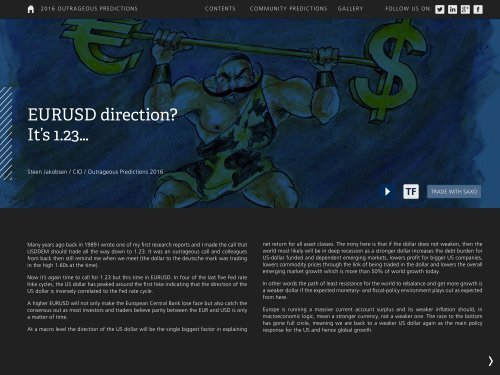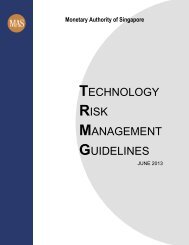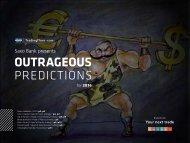saxo prediction
Create successful ePaper yourself
Turn your PDF publications into a flip-book with our unique Google optimized e-Paper software.
2016 OUTRAGEOUS PREDICTIONS<br />
CONTENTS<br />
COMMUNITY PREDICTIONS<br />
GALLERY<br />
FOLLOW US ON:<br />
EURUSD direction?<br />
It’s 1.23…<br />
Steen Jakobsen / CIO / Outrageous Predictions 2016<br />
TRADE WITH SAXO<br />
Many years ago back in 1989 I wrote one of my first research reports and I made the call that<br />
USDDEM should trade all the way down to 1.23. It was an outrageous call and colleagues<br />
from back then still remind me when we meet (the dollar to the deutsche mark was trading<br />
in the high 1.60s at the time).<br />
Now it’s again time to call for 1.23 but this time in EURUSD. In four of the last five Fed rate<br />
hike cycles, the US dollar has peaked around the first hike indicating that the direction of the<br />
US dollar is inversely correlated to the Fed rate cycle.<br />
A higher EURUSD will not only make the European Central Bank lose face but also catch the<br />
consensus out as most investors and traders believe parity between the EUR and USD is only<br />
a matter of time.<br />
At a macro level the direction of the US dollar will be the single biggest factor in explaining<br />
net return for all asset classes. The irony here is that if the dollar does not weaken, then the<br />
world most likely will be in deep recession as a stronger dollar increases the debt burden for<br />
US-dollar funded and dependent emerging markets, lowers profit for bigger US companies,<br />
lowers commodity prices through the link of being traded in the dollar and lowers the overall<br />
emerging market growth which is more than 50% of world growth today.<br />
In other words the path of least resistance for the world to rebalance and get more growth is<br />
a weaker dollar if the expected monetary- and fiscal-policy environment plays out as expected<br />
from here.<br />
Europe is running a massive current account surplus and its weaker inflation should, in<br />
macroeconomic logic, mean a stronger currency, not a weaker one. The race to the bottom<br />
has gone full circle, meaning we are back to a weaker US dollar again as the main policy<br />
response for the US and hence global growth.











